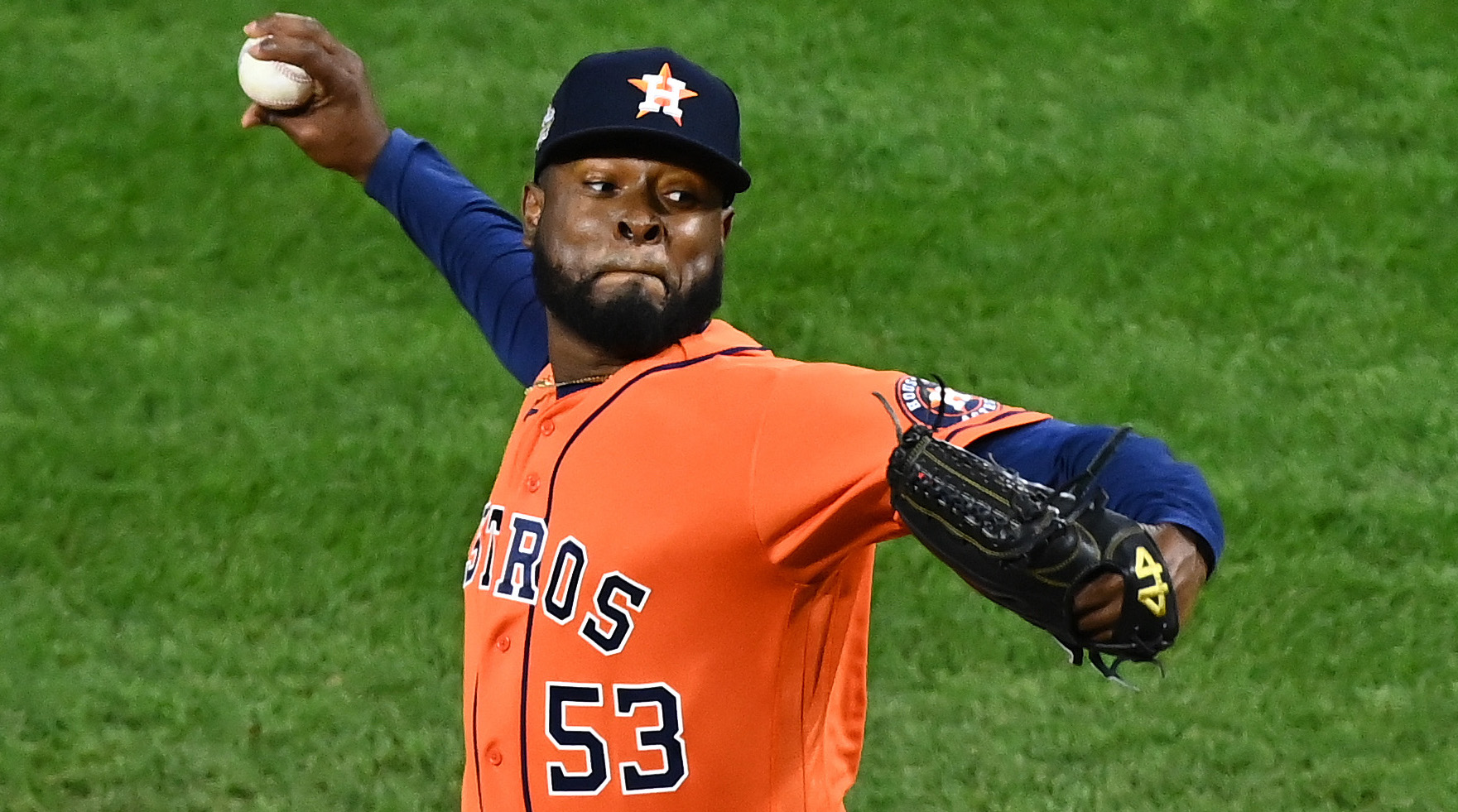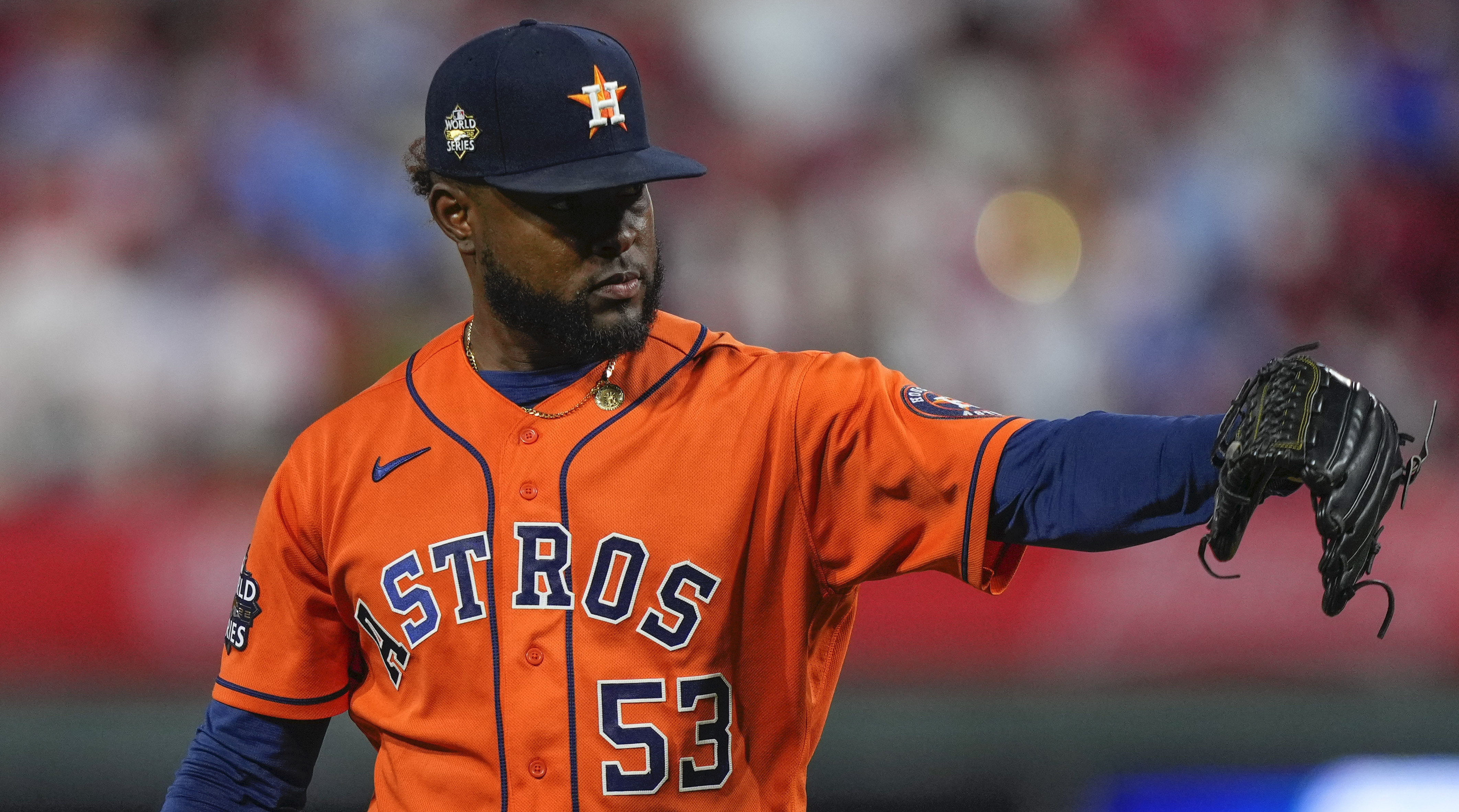Cristian Javier Rides His ‘Invisi-Ball’ to World Series History—in More Ways Than One
PHILADELPHIA — The best kind of history likes to hide around a corner. It taps you on the shoulder from behind in a dark room. It is the unexpected dinner guest ringing your doorbell. It shows up unannounced. It is a World Series no-hitter just when you were watching a seven-runs-a-game juggernaut turn a ballpark into a nightly rave venue.
Surprise! Step aside, Don Larsen. You have company. Four Astros pitchers no-hit the heretofore swaggy Phillies in World Series Game 4, giving them no runners except for three walks. It wasn’t quite Larsen throwing a perfect game by himself in 1956, but it was only the second no-hitter in 688 World Series games.
The relay race of nothingness began with Cristian Javier, the Houston starter who is the David Copperfield of pitchers. The man somehow makes a fastball of ordinary velocity disappear. Javier, 25, covered the first six innings before manager Dusty Baker turned to three relievers in alphabetical order, Bryan Abreu, Rafael Montero and Ryan Pressly. Javier threw the most extraordinary, most mind-blowing game the World Series has seen since pitch tracking began 14 seasons ago.
“He had the best fastball I have ever seen,” says catcher Christian Vázquez, who caught only his second full game in the past 31 days.
APSTEIN: Astros’ Backup Backstop Earns an Outsized Piece of No-Hit History
That’s right: Cristian threw to Christian.
“The two Christians,” marvels Baker, a man who reads his Bible devotionals every early afternoon in his office before the bustle and crackle of the baseball day begins in earnest. “Maybe it was meant to be.”

It happened with Javier’s mother, Trinidad, and father, Cesilio, watching him from the stands at Citizens Bank Park. Trinidad is such an influence on Cristian that the joke around the Astros is that the team has four pitching coaches: the three actually on the major league staff and Trinidad. She continually gives her son pointers, such as, “If they are hitting 95, you need to throw harder, son.” Trinidad had told her son that morning, “You’re going to throw a no-hitter.”
After talking about his mother, Javier sent a request through Jaylen Herrera, a team translator: “Please mention my father, too. I don’t want to get in trouble.”
Cesilio had never seen his son pitch in person as a major leaguer since Cristian made his debut in 2020. The father flew Monday with Trinidad from the Dominican Republic to Philadelphia. The first time he sees his son pitch as an Astro, the kid throws a no-no in the Fall Classic—just as mom predicted.
“When they told me that, obviously I got a lot more motivated,” Javier says. “I kept my faith in God and obviously I knew I had a big commitment today being down 2–1 in the series. And obviously with my parents being here, I just tried to give my best, give my family the best that I could.
“And obviously having my dad here as well so he could enjoy the success that I've had, so he can come here and enjoy the game as well.”
Of his 97 pitches, Javier threw 70 four-seam fastballs, a remarkable 72% daily dose of heat. Since 2008, when pitch tracking began, nobody had ever thrown that many four-seamers in a World Series game. The previous high was 68% by John Lackey in Game 6 of the ’13 Series.
Javier averaged 93.4 miles per hour on his heater, slightly below the major league average (93.9) and below his yearly average (93.8). Still, the Phillies tried swatting 41 times at those 70 fastballs, with all the success of trying to catch a gnat in midair with your hand. They whiffed six times, made an out eight times, and ticked off 27 foul balls, most of them straight back and well into the air as they kept nicking the bottom of his fastball. The ball simply was not in the area they tracked it—just a few inches higher because of the gravity-fighting, Matrix-like qualities of that strange heater.
“How come people don’t hit?” Astros catcher Martín Maldonado says. “Because it’s the invisi-ball.”
“I play catch with him every day,” says bullpen catcher Javier Broccamonte. “The ball just gets on you. You don’t see it. Most pitchers, their arm goes north and south when they throw. Him? It goes east and west. So he hides the ball, and then it just shoots out. And then it has so much life to it. It’s amazing.”
While pitchers and hitters have their noses buried in iPads, and pitchers such as Houston righthander Lance McCullers Jr. mitigates giving up seven runs by comfort from the pitch data, such as spin rates and vertical and horizontal movement, Javier’s fastball is a natural wonder. It has always been that way.

Growing up in Santo Domingo, mostly as an outfielder, Javier was not signed at 16, the way the top international free agents are. Just as he turned 18 in 2015, Javier was throwing 84-86 mph when Astros scouts Román Ocumarez and Johan Maya recommended him to Oz Ocampo, the team’s international scouting director. They liked his clean delivery. They described him as “an elite mover,” a way of capturing his kinetic athleticism in scout-speak. Most of all, they loved that fastball. They signed him for just $10,000.
In Javier, Abreu, Framber Valdez (all from the Dominican), Luis Garcia (Venezuela) and José Urquidy (Mexico), the Astros signed five of their 13 World Series pitchers for a combined $180,000—or less than the cost of a year’s supply of baseballs (about $203,000, at about $7 per ball bulk cost.)
Javier carried himself with such cold-blooded calmness on and off the mound that teammates nicknamed him El Reptile.
“The first time I saw him was in Kissimmee in 2016,” Astros (official) pitching coach Josh Miller says, referring to when Javier, then 19, was at minor league spring training. “It was the same arm action and the same way the ball came out of his hand.”
Over the years, the Astros tightened his slider and tweaked his knuckle-curve and changeup, but that magical four-seamer they left alone. The pitch is hellacious because of its mysterious “ride,” which is a measurement of defying gravity.
Every fastball drops. Pitchers throw from an average of about six feet off the ground (Javier actually has a low release point, 5.65 feet, which aids his deception) and the ball crosses the plate at about three feet off the ground near the top of the zone. But because of how the baseball comes out of his hand—his spin is good, but not elite—his fastball doesn’t drop as much as the average fastball of the same velocity. His fastball is three inches higher than where it should be, based on the average fastball. Only the fastball of Nestor Cortes Jr. of the Yankees has a greater gap between perception and reality (3.2 inches).
That’s why you see hitters fouling back fastballs. They aim to hit the center of the ball but hit the bottom because it holds his plane more than the catalog of fastballs in their head.
Cristian Javier, K'ing the Side. 🔥🦎
— Rob Friedman (@PitchingNinja) November 3, 2022
7Ks thru 4. pic.twitter.com/A8FLOylT4t
Javier threw 60% fastballs this year. Only Spencer Strider, Michael Kopech and Carlos Rodon threw a fastball more often. Nobody threw more high fastballs from a low release point—the gold standard of deception—than Javier.
For two months, Javier’s fastball has been nearly unhittable. Since Sept. 8, Javier has allowed one run over 38 innings. During that time opponents are 8-for-117, a .068 batting average.
World Series Game 4 was so 2022 baseball, what with a dominant starter getting pulled with less than 100 pitches (his pitch high this year was 115, and he was unlikely to come close to finishing the game near that amount) and one reliever with wicked stuff after another. But in another way, it pulled the game back to another era, when fastball was king.
Since 2008, only three pitchers topped Javier’s 72% fastball percentage in any postseason game of at least 90 pitches, all of them eight or more years ago: Jordan Zimmermann (85%, 2014 NLDS 2), Vicente Padilla (75%, 2009 NLDS 3) and Matt Garza (75%, 2008 ALCS 7 and 74% 2008 ALCS 3). Pitchers just don’t challenge hitters like that anymore—until an unseasonably warm night at the Bank.
The Phillies’ 6–0 postseason run at home was stopped. It ended with a magic show. That his parents were there to watch it made the night even more historic for Javier.
“For me, it was the best gift that I could have ever given ’em,” Javier said. “I know that they’re really proud of me for what I was able to accomplish today.”
More MLB Coverage:
• Astros’ Backup Backstop Earns an Outsized Piece of No-Hit History
• Phillies’ Night Unravels After Aaron Nola’s Final Batter
• The Large Lovable Lads Who Crush Dingers
• How the Phillies Figured Out Lance McCullers Jr.
• The Dazzling Defense of Defensive Liability Nick Castellanos
